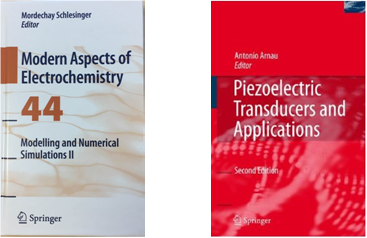(ac-electrogravimetry ou AC-EG)
Contact: H. Perrot (hubert.perrot@sorbonne-universite.fr)
The quartz microbalance is a highly sensitive gravimetric sensor that allows mass variation measurements in the nanogram range and in situ in a liquid medium. Electrochemical impedance is based on the determination of the transfer function![]() at various frequencies of modulation. Thanks to the good quality of our lab-made microbalances, it is possible to measure a new transfer function, called electrogravimetric transfer function and noted
at various frequencies of modulation. Thanks to the good quality of our lab-made microbalances, it is possible to measure a new transfer function, called electrogravimetric transfer function and noted ![]() : following a low level sinusoidal voltage perturbation of an electrochemical system in the steady state, the mass response of the system is measured using a fast microbalance device. The signal from the latter is sent to a good quality frequency/voltage converter in order to be able to measure these mass variations using a multi-channel transfer function analyzer such as Solartron 1254. Indeed, this measuring device allows us to simultaneously determine the two main transfer functions
: following a low level sinusoidal voltage perturbation of an electrochemical system in the steady state, the mass response of the system is measured using a fast microbalance device. The signal from the latter is sent to a good quality frequency/voltage converter in order to be able to measure these mass variations using a multi-channel transfer function analyzer such as Solartron 1254. Indeed, this measuring device allows us to simultaneously determine the two main transfer functions ![]() et
et ![]() .1,2
.1,2
The combination of these two transfer functions provides a very powerful analytical tool for studying the electrode/electrolyte interface as shown below.
From models, it is possible to characterize from a kinetic point of view the electrochemical system studied, to separate the contribution of the different species involved in charge compensation processes as well as their concentration and nature. This approach is particularly suitable for finely studying the behaviour of ionic and/or electronic conducting materials used in the field of energy storage and chemical detection in liquid media.
The attached diagram shows the theoretical transfer function in the complex plane ![]() or different configurations. Some conditions may show only the contribution of a cation (1) or an anion (2) or more complex configurations that include more than one species (3-6). In the latter case, different kinetic constants were also taken into account (example: an anion faster than a cation (4)). The electrogravimetric transfer function can also detect the contribution of the free solvent (not shown here) From models, it is possible to characterize from a kinetic point of view the electrochemical system studied, to separate the contribution of the different species involved in charge compensation processes as well as their concentration and nature. This approach is particularly suitable for finely studying the behaviour of ionic and/or electronic conductive materials used in the field of energy storage and detection in liquid media.
or different configurations. Some conditions may show only the contribution of a cation (1) or an anion (2) or more complex configurations that include more than one species (3-6). In the latter case, different kinetic constants were also taken into account (example: an anion faster than a cation (4)). The electrogravimetric transfer function can also detect the contribution of the free solvent (not shown here) From models, it is possible to characterize from a kinetic point of view the electrochemical system studied, to separate the contribution of the different species involved in charge compensation processes as well as their concentration and nature. This approach is particularly suitable for finely studying the behaviour of ionic and/or electronic conductive materials used in the field of energy storage and detection in liquid media.
Different electrochemical systems can thus be finely characterized: metal electrodeposition mechanism (copper, iron, metal oxide...), behaviour of ionic and electronic conductive materials in solution (Prussian blue, polyaniline, polypyrrole...).1-4 Other more complex materials have also been studied, such as PVC/polypyrrole sandwich structures for the development of chemical sensors or proton-conducting membranes in two-layer configuration. AC-EG has recently been applied to study the charge storage mechanisms in metal oxide (MnO2) and carbonaceous material electrodes and the insertion of Li+ in electrochromic films such as WO3.5-8
Références :
1. C. Gabrielli, J.J. Garcia-Jareño, M. Keddam, H. Perrot, F. Vicente, Ac-Electrogravimetry Study of Electroactive Thin Films. I. Application to Prussian Blue, J. Phys. Chem. B 106 (2002) 3182-3191.
2. C. Gabrielli, J.J. Garcia-Jareño, M. Keddam, H. Perrot, F. Vicente, Ac-Electrogravimetry Study of Electroactive Thin Films. II. Application to Polypyrrole, J. Phys. Chem. B 106 (2002) 3192-3201.
3. L.T.T. Kim, C. Gabrielli, A. Pailleret, H. Perrot, Correlation between ion-exchange properties and swelling/shrinking processes in hexasulfonated calix[6]arene doped polypyrrole films: ac-electrogravimetry and electrochemical atomic force microscopy investigations, Electrochim. Acta 56 (2011) 3516-3525.
4. J. Agrisuelas, C. Gabrielli, J. J. Garcia-Jareno, H. Perrot, O. Sel, F. Vicente, Polymer dynamics in thin p-type conducting films investigated by ac-electrogravimetry. Kinetics aspects on anion exclusion, free solvent transfer, and conformational changes in poly(o-toluidine), Electrochim. Acta 153 (2015) 33-43.
5. C.R. Arias, C. Debiemme-Chouvy, C. Gabrielli, C. Laberty-Robert, A. Pailleret, H. Perrot, O. Sel, New Insights into Pseudocapacitive Charge-Storage Mechanisms in Li-Birnessite Type MnO2 Monitored by Fast Quartz Crystal Microbalance Methods, J. Phys. Chem. C 118 (2014) 26551-26559.
6. F. Razzaghi, C. Debiemme-Chouvy, F. Pillier, H. Perrot, O. Sel, Ion intercalation dynamics of electrosynthesized mesoporous WO3 thin films studied by multi-scale coupled electrogravimetric methods, Phys. Chem. Chem. Phys. 17 (2015) 14773-14787.
7. F. Escobar-Teran, A. Arnau, J.V. Garcia, Y. Jiménez, H. Perrot, O. Sel, Gravimetric and dynamic deconvolution of global EQCM response of carbon nanotube based electrodes by Ac-electrogravimetry, Electrochem. Comm. (70) 2016 73-77.
8. H. Goubaa, F. Escobar-Teran, I. Ressam, W. Gao, A. El Kadib, I. T. Lucas, M. Raihane, M. Lahcini, H. Perrot, O. Sel, Dynamic Resolution of Ion Transfer in Electrochemically Reduced Graphene Oxides Revealed by Electrogravimetric Impedance, J. Phys. Chem C 121 (2017) 9370–9380.
Books:










